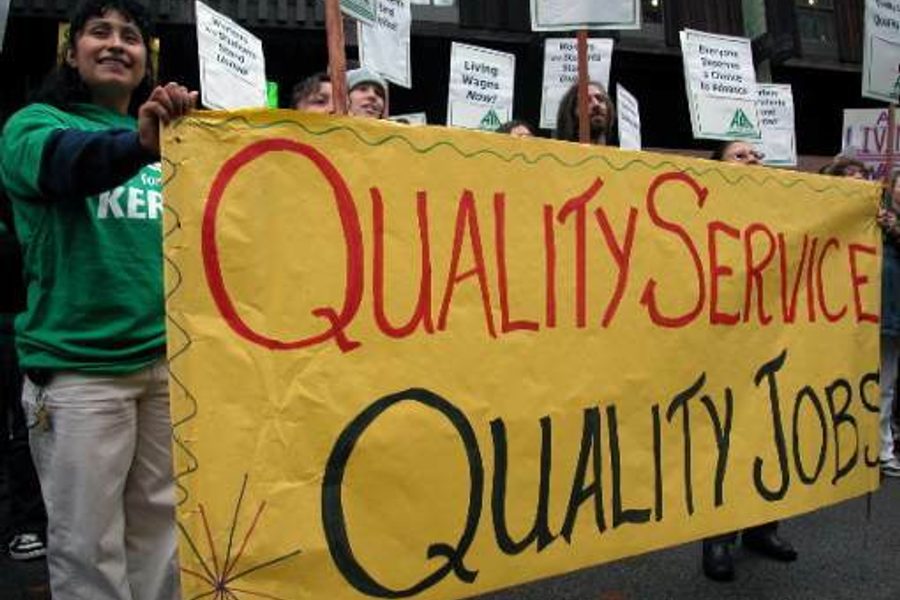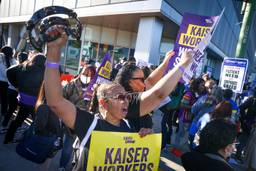
Want to get a disgruntled worker really mad? Just point to his arch enemy: the civil servant. You know, the shiftless paper-pusher, fattened on our tax dollars, the epitome of “waste, fraud and abuse.”
Alright, this might sound harsh to those of us who still think the government has some useful functions in society today. But bashing on the government and its workers has become a favorite pastime for conservatives like New Jersey Governor Chris Christie, who has argued that public employees enjoy undeservedly lavish compensation packages while their private-sector counterparts grapple with shrinking paychecks. So the logic goes: Why should struggling families’ tax dollars finance the bloated wages of bureaucrats?
An analysis of New England public employees by the Center for Economic Policy and Research and Political Economy Research Institute helps dispel the myth of the “spoiled” government worker. Researchers found that New England’s state and local workers are actually comparatively disadvantaged. After taking into account variables like age and education level, “state and local workers actually earn less, on average, than their private-sector counterparts.”
While it’s true that the public workers in the study have higher average incomes, this is primarily due to their higher ages and educational credentials. All in all:
While low-wage workers in New England receive a small wage premium in state and local jobs (about 5 percent for a typical low-wage worker), the typical middle-wage worker earns about 3 percent less in state and local work, and the typical high-wage worker makes about 13 percent less than a similar private-sector worker.
The government workers do tend to have better benefits, like sick leave and health insurance. But the researchers explained, “Benefits offered by state and local governments are roughly as generous as those offered by large firms in the private sector” (presumably when they’re not busy laying people off in droves).
Separate studies by the Economic Policy Institute have come to similar conclusions about public-private sector parity. In Gov. Christie’s state, for example:
New Jersey public employees, both state and local government employees, are not overpaid, but neither are they under compensated. When we make comparisons controlling for education, experience, hours of work, organizational size, gender, race, ethnicity, and disability, there is no significant difference between private and public employee compensation costs.
Besides the empirical evidence, more important than the direct comparison, is the question of why the public sector is such an easy target for populist rage, rather than, say, billionaire CEO’s who have barely been nicked by the recession. Maybe we’ve been trained to internalize an unshakeable belief in the sanctity of the “free market” and to see the state as militating against the “natural” rationality of private enterprise.
Buried in this pro-market groupthink is a stealth campaign against public sector workers, and by extension, the country’s last substantial bastion of organized labor. Union workers currently make up about 37 percent of the government workforce, more than five times the private-sector unionization rate.
John Buntin at Governing argues that despite government employees’ reputation as “spoiled rotten” (promoted by right-wing think tanks like the Manhattan Institute), the modest advantages enjoyed by public sector workers are the product of a long labor-management struggle:
Benefits are also important, and the benefits of many public-sector unions are famously generous. That’s because when unions first started to organize the public work force nearly four decades ago, many chose to avoid the more visible and controversial issue of wages in favor of the promise of more generous treatment in the future. As a result of this strategy, most public-sector workers - 84 percent - still enjoy traditional, defined benefit pensions that, after their retirement, pay them a fixed amount every month. In comparison, 81 percent of private-sector employees now rely on defined contribution plans such as 401(k)s, where workers save a portion of their earnings (which may or may not be matched by their employers) and then upon retiring, receive a lump sum payment.
Much of that progress, unfortunately, now risks being squandered in a flurry of budget cuts or, as the Public Interest points out, an aggressive push toward privatization of public institutions.
The government timecard further complicates the picture. CEPR and PERI found that public sector workers typically work fewer hours, which suggests that it may be the government agency, and not the strip mall or corporate office, that provides the more sensible work environment.
Yet politicians still seize on populist anger to justify slashing government payrolls. Private sector workers who have been devastated by the recession might find catharsis in railing against their kid’s teacher, or the clerk at the unemployment office. But it’s all too easy to slip reflexively into anger at peers rather than question, on a structural level, what separates those who get their fair share from those who don’t.
Reactionary politics have perverted the concept of “shared sacrifice” into a standoff between the public and private economic realms. But drawing this artificial divide keeps workers from finding common ground in challenging corporate power from the bottom up.

I hope you found this article important. Before you leave, I want to ask you to consider supporting our work with a donation. In These Times needs readers like you to help sustain our mission. We don’t depend on—or want—corporate advertising or deep-pocketed billionaires to fund our journalism. We’re supported by you, the reader, so we can focus on covering the issues that matter most to the progressive movement without fear or compromise.
Our work isn’t hidden behind a paywall because of people like you who support our journalism. We want to keep it that way. If you value the work we do and the movements we cover, please consider donating to In These Times.
Michelle Chen is a contributing writer at In These Times and The Nation, a contributing editor at Dissent and a co-producer of the “Belabored” podcast. She studies history at the CUNY Graduate Center. She tweets at @meeshellchen.







